Webinar Recap: More Content Bang for Your CMS Buck With Forrester
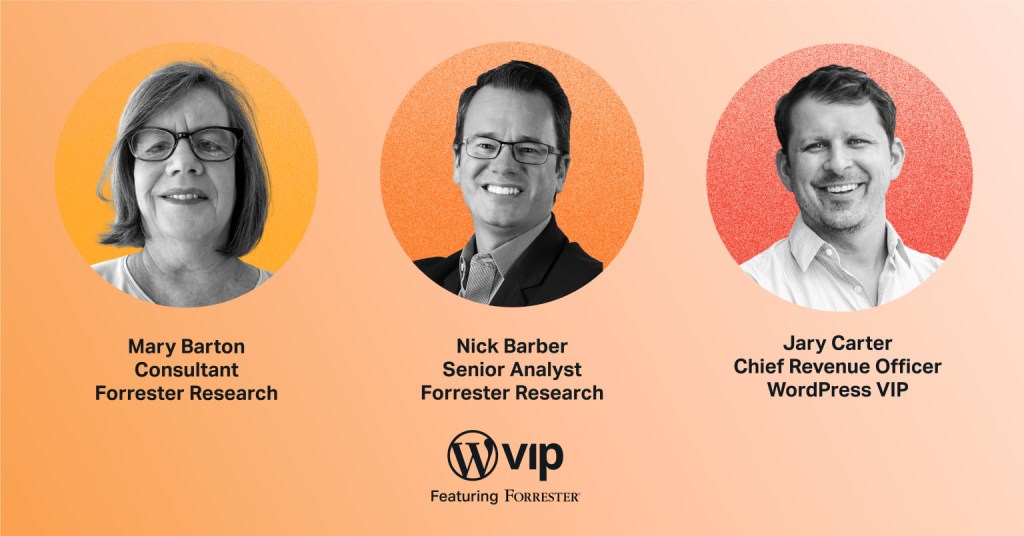
According to a new study by Forrester Consulting, commissioned on behalf of Automattic, businesses struggle with development cost, assembling the right team of writers, creating meaningful and reliable digital experiences, and a lack of visibility into content performance.
Last week, Jary Carter, CRO of WordPress VIP, joined Forrester Senior Analyst Nick Barber and Forrester Consultant Mary Barton, on a webinar: Getting More Content Bang for Your CMS Buck. They discussed these challenges, and how WordPress VIP is helping organizations not only rise to meet them, but also become “customer obsessed.”
Our presenters
Nick is a senior analyst serving application development and delivery professionals. He’s particularly interested in how personalized customer experiences live at the intersection of data and content, and how the understanding of that content can be augmented with artificial intelligence.
Mary is a consultant on the Forrester Total Economic Impact (TEI) side, where she develops the business use case for technology investments and initiatives. She recently conducted a TEI Report for WordPress VIP, looking at the costs and benefits of adopting an agile content platform.
Highlights of the session:
- Smart technology investments help stave off brand irrelevancy
- Growth in digital maturity spurred by the pandemic
- Forrester TEI report – WordPress VIP
- Key challenges and three-year impact
Smart technology investments help stave off brand irrelevancy
Nick:
I want to start with a problem that you all, as brands, are experiencing. You are all hurtling towards irrelevancy. We know this because our data tells us that half of companies on the S&P 500 will be replaced in a decade.
What you need to do today is set yourself up to avoid that irrelevancy, so that you stay ahead of your competitors and stay at the top, in terms of offering a differentiated customer experience.
What we’re going to talk about today is how smart investments in technology can help you stave off that potential future of becoming irrelevant as a brand.
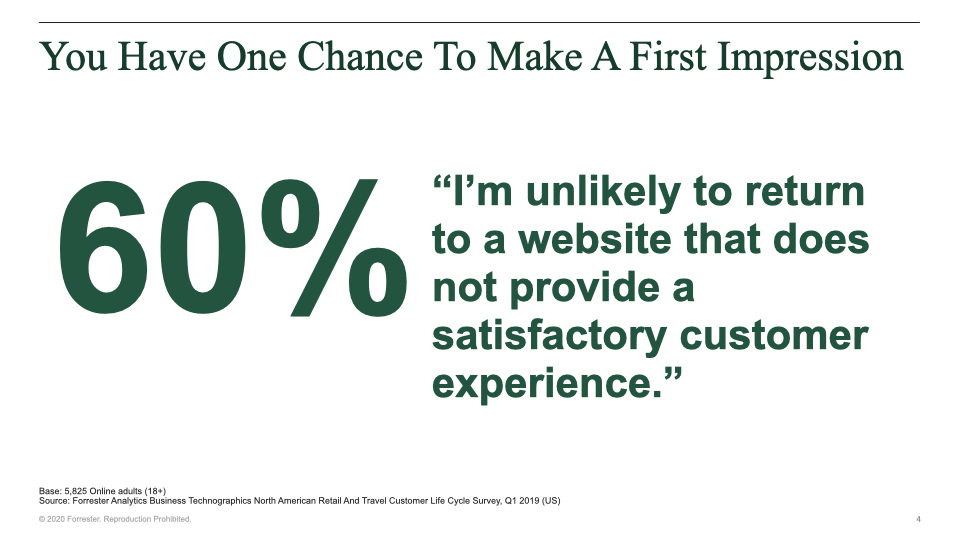
Our data tells us that you have one chance to make a first impression with your customers. We know this because 60% of the online adults that we surveyed said, “I’m unlikely to return to a website that does not provide a satisfactory customer experience.”
We know through this idea of hyper-adoption and hyper-abandonment that it’s really easy to adopt a new relationship with a new brand or abandon one with an existing brand. If you don’t make a good first impression via your digital experience, then your competitor’s going to.

Digital experiences are incredibly complex when you take into account all of the channels that you, as a brand, need to serve, all of the devices that you need to serve, and all of the segments you need to serve. And now you need to start delivering personalization across all of those channels.
What a lot of brands have done is they’ve tried to use old styles of engagements. This idea of the customers being on the outside, experiencing the way the brand wants the customer to experience—these old styles of engagement simply won’t work anymore.
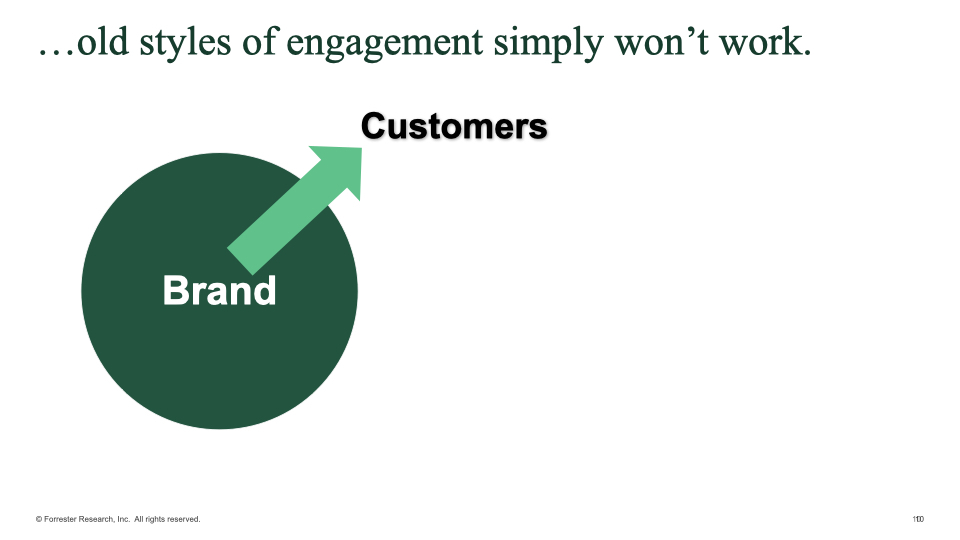
Instead, what needs to happen is the customers need to decide how they’re going to work with the brand, how they’re going to engage with the brand.
So, when creating digital experiences and investing in technology, brands need to make sure that they can be flexible, so they can adapt to their new customers.
We know that technology helps solve complexity, and smart firms have invested in it. So, when we look at businesses across the board, we group them into different buckets, around how they align with the principle that Forrester calls “customer obsession.”
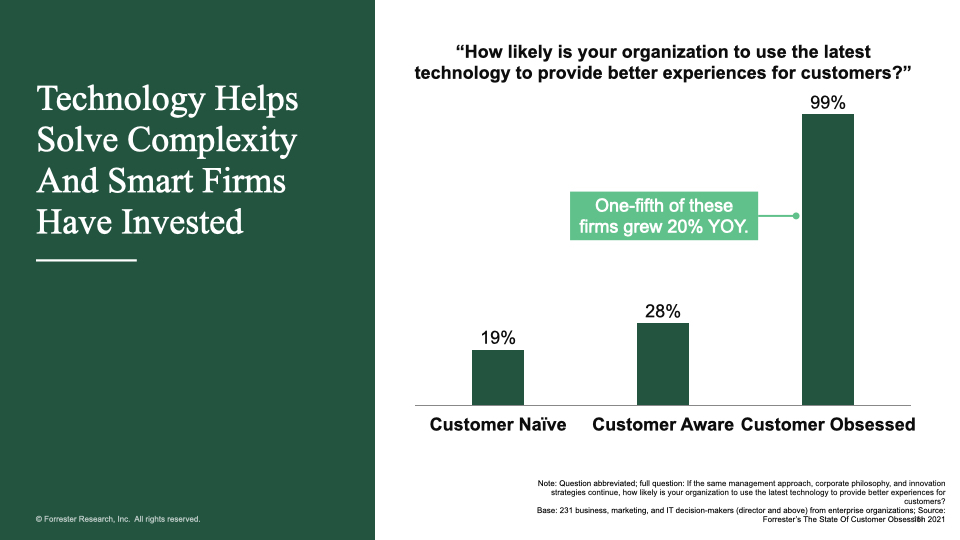
You can see here that we’ve got “customer naive,” “customer aware,” and “customer obsessed” brands, increasing in their level of customer obsession.
When we asked these companies, “How likely is your organization to use the latest technology to provide better experiences for customers?” 99% of the customer obsessed brands said, “Yes, that’s us.”
Fewer than one in five customer naive brands prioritize technology investment, which is part of the reason that they live in that customer naive segment.
Of those customer obsessed firms that invested in technology, one fifth of them grew 20% year over year.
So, we’ve got three pieces here: smart technology, investments, customer obsession, and now explosive growth, all tied to investing in the latest technology to create better experiences.
Jary:
We hear brands saying that customer experience is their only source of sustainable competitive advantage. Brand awareness, even pricing, is less important than it used to be. We hear words like “effortless customer experience” as critical.
Is the reason you’re seeing this shift and this hyper-growth in the customer obsessed group because they’re actually taking market share from these companies that are going to be dying over the next 10, 15 years? Is that how you’re thinking about that?”
Nick:
Yeah, it’s all of that. It’s all about creating experiences that are effective, that are efficient, that have emotional connection with our customers—because those are things that unlock memory, trust, and all of that goodness that brands are looking for.
Also, going back to basic marketing, we know it’s less expensive to serve our existing customers and keep them satisfied than it is to go out and acquire new ones. So, it’s about creating that sustained positive customer experience that builds up this reservoir of goodwill.
When a brand is looking to innovate, or shift, and they mess up, which they inevitably will, they can pull from that reservoir of goodwill that they’ve built up with their client base.
Customer obsession does a lot in terms of serving the existing customers, as well as providing that buffer for the brand, so that they can innovate and shift and not necessarily worry about being punished in the immediate short-term if they mess up.
Growth in digital maturity spurred by the pandemic
Nick:
For a long time, the most advanced digitally mature companies were few and far between, but we’ve seen huge growth during the pandemic. When we look at companies in terms of their digital maturity, 31% are “digital beginners,” the bulk fall into intermediate,” and 24% fall into digitally advanced.”
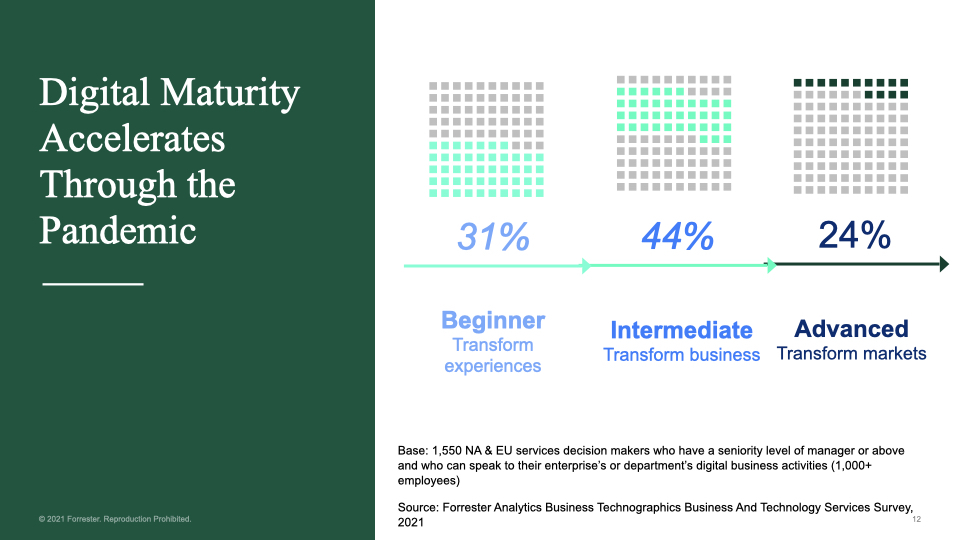
The big takeaway here is that just two or three years ago, pre-pandemic, the number of advanced companies was just 14%. So in two or three years, it’s grown 10%, which is huge.
This reinforces our hypothesis that, as horrible as it was and is, the pandemic has started to rip the band-aid off of poor digital experiences.
So what do you need to do to create the intelligent content stack you need to better serve your customers via digital experiences?
Analytics, automation, and embedded AI are the capabilities you need to uplevel those experiences. And these aren’t things that you need to go out and buy anymore. They’re already woven into the different technologies in your stack. It’s about making smart use of those capabilities, across your stack in order to better serve your customers via personalization.
Forrester TEI report – WordPress VIP
Mary:
The TEI is a proven, consistent, repeatable methodology that Forrester uses to develop the business case considering the benefits, the costs, and the flexibility that’s provided by a solution, as well as the risk an organization might see with that technology investment.
We independently interviewed several customers of WordPress VIP and created a representative composite organization from that information. Then, we applied the data from our interviews to create a financial model and case study that businesses can use in developing their understanding of how WordPress VIP might impact their organization.
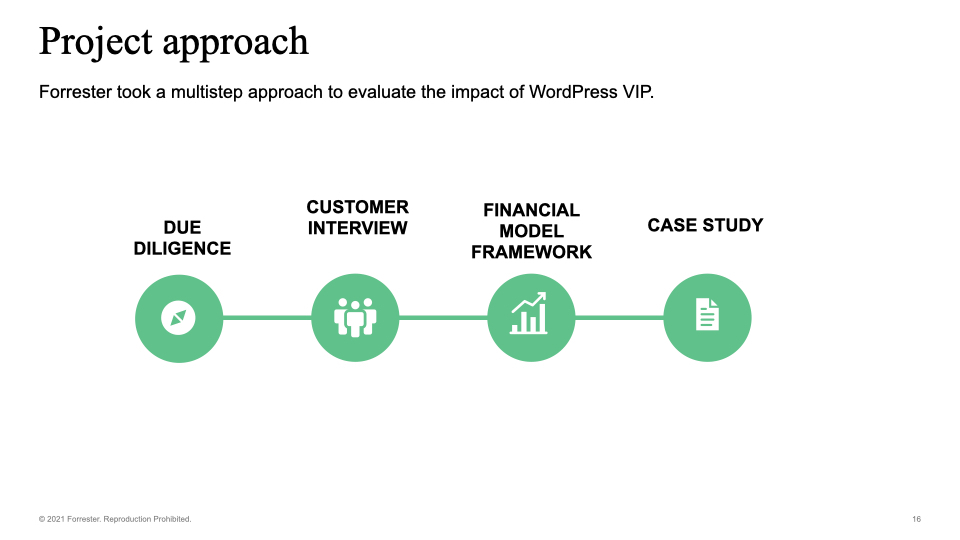
We started with a group of customers that are experienced users of WordPress VIP, who’ve been using the platform for three years or more. They had varying deployment sizes, from one site to double digits, and we spoke with people at different levels of seniority within the organizations.

Key challenges and three-year impact
Mary:
When we asked these WordPress VIP customers what their key challenges were, why they began looking for a better platform, one of the challenges they cited was “disparate hosting solutions across the organization.” They wanted to bring them all together and standardize across their systems.
There were also concerns with maintenance and security, cost of development, as well as a difficulty in understanding how well any of their content was being received.
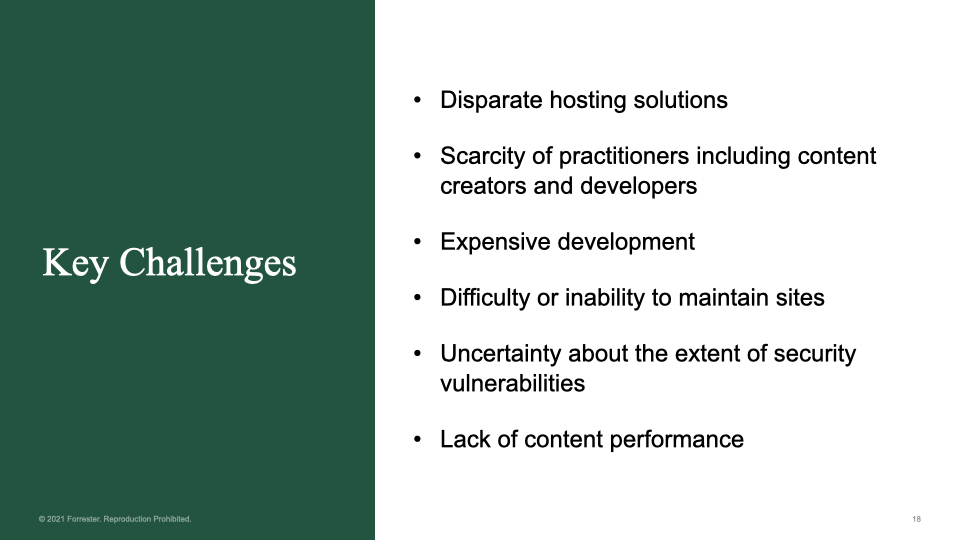
Here’s a look at the three-year, risk-adjusted impact that the composite organization we studied saw after adopting WordPress VIP. The overall results: an ROI of over 400% and benefits of around $3.5 million.
These outcomes stemmed from efficiency and cost savings, faster and less expensive development, better reliability and security, and improved analytics.
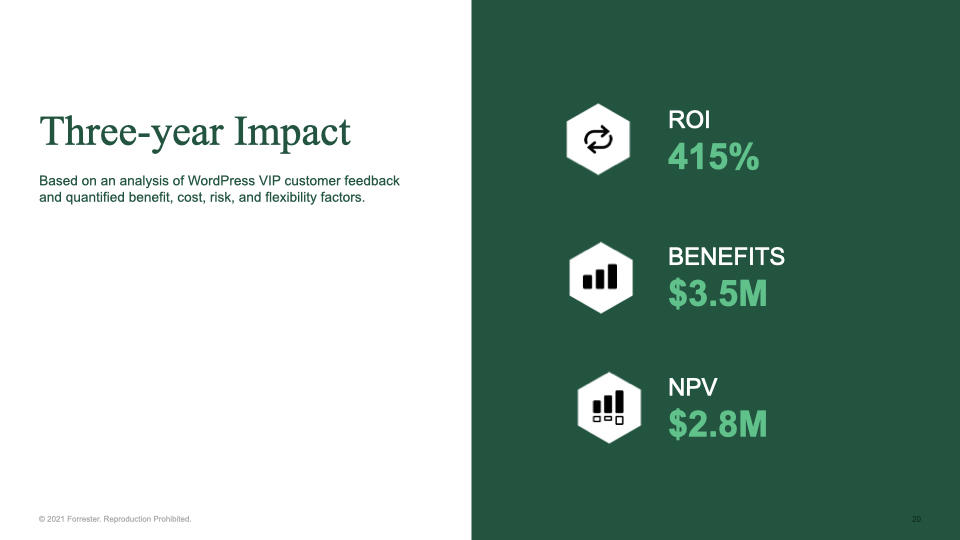
One of the main drivers of those results was the large WordPress VIP developer ecosystem.
Forty percent of the internet runs on WordPress. There are a lot of people who know how to work with it, there’s a lot of information available, and there are already lots of apps and widgets that help you do what you want to do without having to develop from scratch.
Interviewees estimated that their organizations saved as much as 50% in development and maintenance costs with WordPress VIP.
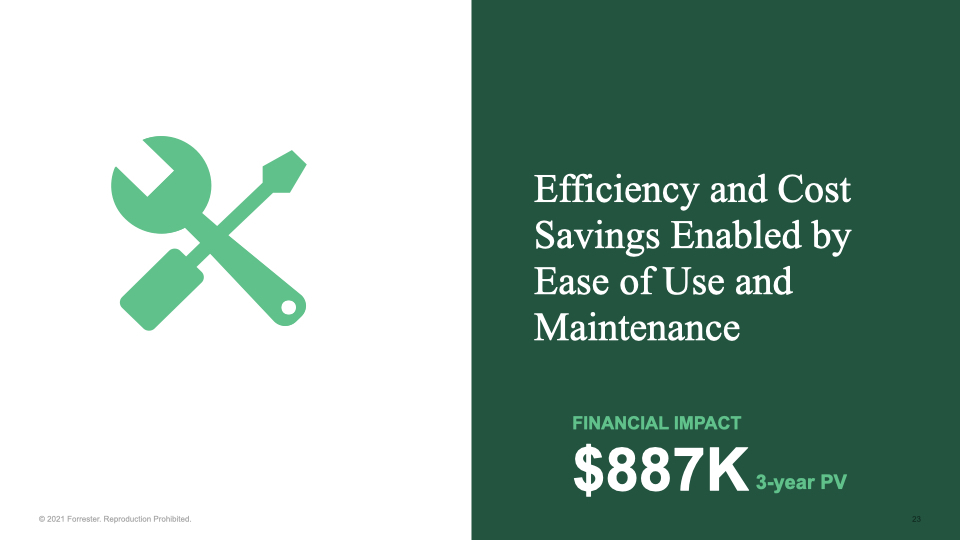
I used to worry about maintenance a lot, but now it’s all handled by WordPress VIP, or by the agency we work with. And they work so well together that maintenance downtime becomes a non-issue for us. It just happens quietly in the background, and we never hear about it. WordPress is so prevalent that a lot of people already know how to use it, so there’s no training costs associated with it.
—WordPress VIP Lead UX Designer
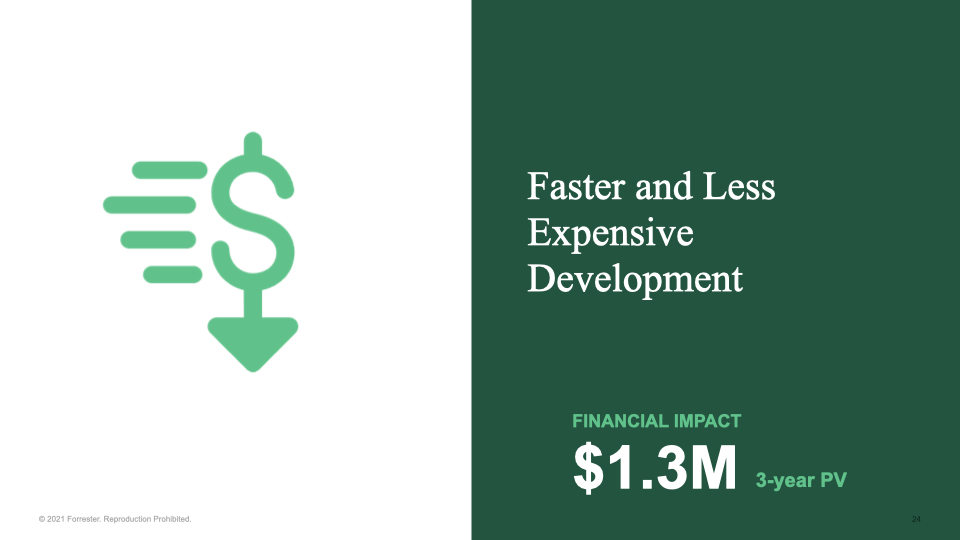
Next, we looked at better reliability and security with WordPress VIP. A problem that was identified for our respondents was that many people weren’t even sure what their security situation was.
One respondent said: “We’re really pleased with WordPress VIP’s commitment to cybersecurity, in the way that they store their data and all the various checks and balances that keep somebody from being able to get access to our site.”
You can understand how that’s really important to some of the customers we spoke to, particularly those in the pharmaceutical industry.

Then, we looked at improved business results from analytics through WordPress VIP, which ties into what Nick was saying about being able to develop those personalized experiences.
One respondent said: “People have Parse.ly open all day every day so that they’re constantly monitoring how content is being received. The data transparency and democratization across the whole organization has also been one of the biggest values.”
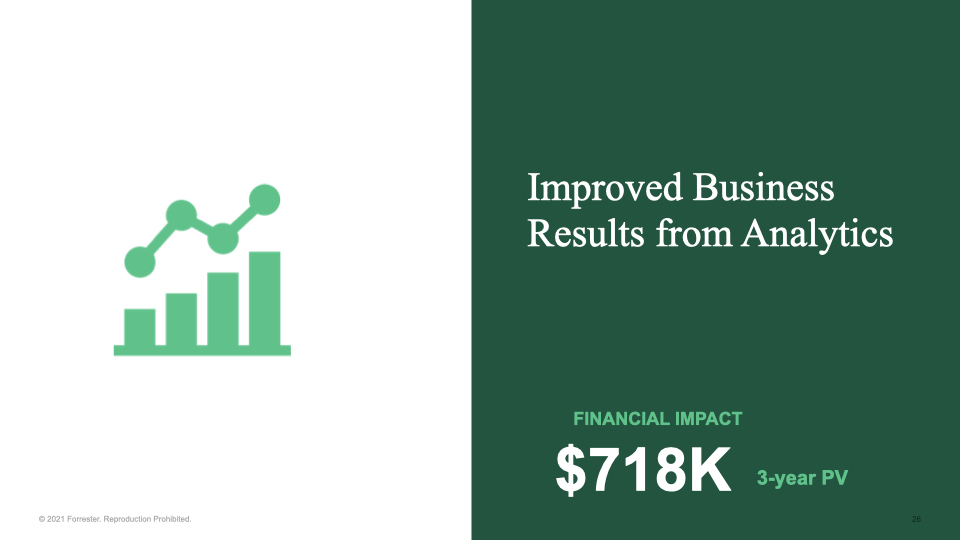
Finally, we looked at the unquantified benefits of WordPress VIP—the benefits to an organization that customers just haven’t developed metrics for.
One Senior Manager of Marketing Technology said: “The fact that we’re able to bring our marketers to a more stable platform and give them the right tools to scale does impact the way those folks feel about the day-to-day job. It’s really freedom from thinking about all the things that could go wrong, and instead focusing on the strategy and on driving campaigns.”
In the “decreased time-to-market category,” we hear things like: “We’re able to create a page and start the campaign within a few hours, instead of having to wait weeks and weeks to be able to get it done on a different platform.”
This has just been a sampling of what’s covered in the full report, so I encourage you to get a full copy for yourself.